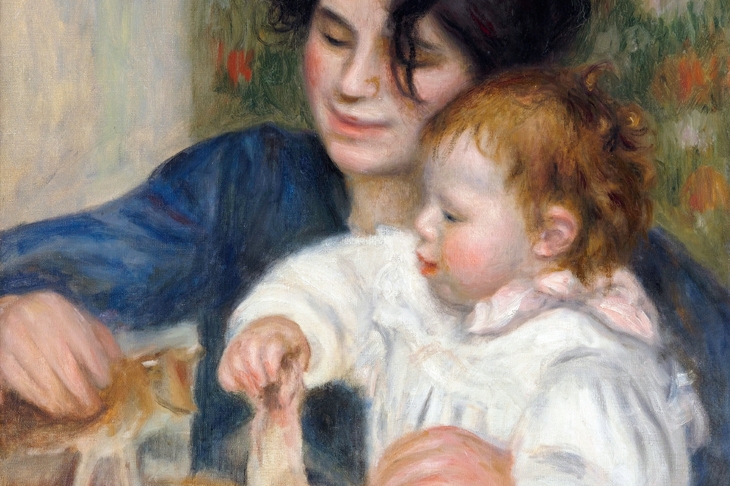In 1959 the formidable interviewer John Freeman took the Face to Face crew to the 81-year-old Augustus John’s studio. The beetling brow, piercing eye and a succession of roll-ups stuck to his lower lip offer almost a caricature of the undimmed rascality of the old devil. Like all the films in that remarkable series, it offers a glimpse into a world that we thought television was invented too late to record. But how much more extraordinary it is to watch, in a three-minute film made in 1915, another elderly artist — the 74-year-old Pierre-Auguste Renoir, crippled with arthritis, working at his easel. The externals are similar — the beard, the arty getup, the cigarette — but even in this silent film Renoir’s chatty urbanity speaks volumes about a man built in a very different vein.
Renoir was the only one of the great Impressionist painters to come from truly humble origins — his father was a tailor and his mother a seamstress — and he entered art school after an apprenticeship painting figures and flowers on porcelain and decorative schemes on window blinds. For most of his fellow artists the struggle was for recognition of their artistic innovation — the vibrant portrayal of light and reflected light in short, brightly coloured brush strokes. For Renoir the struggle was also a financial one, and, according to Barbara Ehrlich White, the struggle of the outsider to swim in a social world where he was out of his depth.
To this cause she attributes his anxiety, nervous tics, inability to make decisions and fear of confrontation. To Pissarro he was ‘that most inconsistent of men’, and in trawling through some 3,000 of Renoir’s letters, White has attempted to chart his inconsistent life in an exhaustive study that stands as a companion piece to her earlier Renoir: His Life, Art and Letters.
Renoir’s artistic career, like those of the other Impressionists, had no straight-forward trajectory. His work was shown alongside that of Monet, Sisley, Morisot, Cézanne and Pissarro at the first ‘Impressionist’ exhibition in 1874; but as he tailored his style to suit the public taste his work was accepted by the Salon and he abandoned the company of the refusés for the more lucrative possibilities of establishment favour.
For more than a decade he was still dependent on the generosity of friends and patrons, but by interleaving his more daring landscapes and figure paintings with commissioned portraits he was able, more or less, to stay financially afloat until, at the end of the 1880s the American market recognised his genius and secured his future.
His ‘intimate’ life similarly proceeded in an irregular fashion — by his first model Lise he had two children, one of whom disappears into the mists of time; the other, Jeanne, Renoir supported for the rest of his life, though kept her existence secret from his wife. As the family fortunes rose Renoir’s relations with Aline, his wife, the mother of his three sons and the model for many of his major works, deteriorated to the point where they rarely lived in the same house at the same time. From his mid-fifties Renoir’s health also declined, as rheumatoid arthritis began its pernicious course — by the time the 1915 film was made he could only paint with the help of his son Coco inserting a paintbrush into his clawlike hand.
Beneath the surface, too, the anxieties and inconsistencies raged — he feared being tarnished by association with Pissarro’s anarchism; he dreaded Monet’s disapproval when he accepted the Légion d’Honneur; he expressed anti-Semitic views, while being friendly with both relations and business associates who were Jewish; and he told a journalist that ‘the woman artist is completely ridiculous’ while remaining a close friend and admirer of Berthe Morisot.
But his worries and adversities were never the subject of his paintings, and the exuberance evident in canvas after canvas was echoed by the testimony of his many friends, who marvelled at his good humour and stoicism. He continued painting until the last day of his life, his style evolving as his physical condition changed. By the time of his death in 1919 it could justly be said that his work slotted into a continuum that ranged from Pompeii frescoes to Raphael and Rubens and on into the future: his influence was felt by both Matisse and Picasso.
This book is the fruit of 60 years of research and scholarship — about the same length of time as Renoir’s career. There is probably no one, including Renoir himself, who has ever known more about Renoir, and this book will doubtless remain the ultimate quarry for any future biographer or scholar. For the general reader however, its comprehensiveness is also its problem. If you want to know every last detail of every address where Renoir lived; read every word on every birth, marriage and death certificate of every member of his family; if you want every statement backed up with a quotation, then this is the book for you. If not, then perhaps his son Jean’s memoir, with all its warmth and with all its faults, still has something to say.






Comments